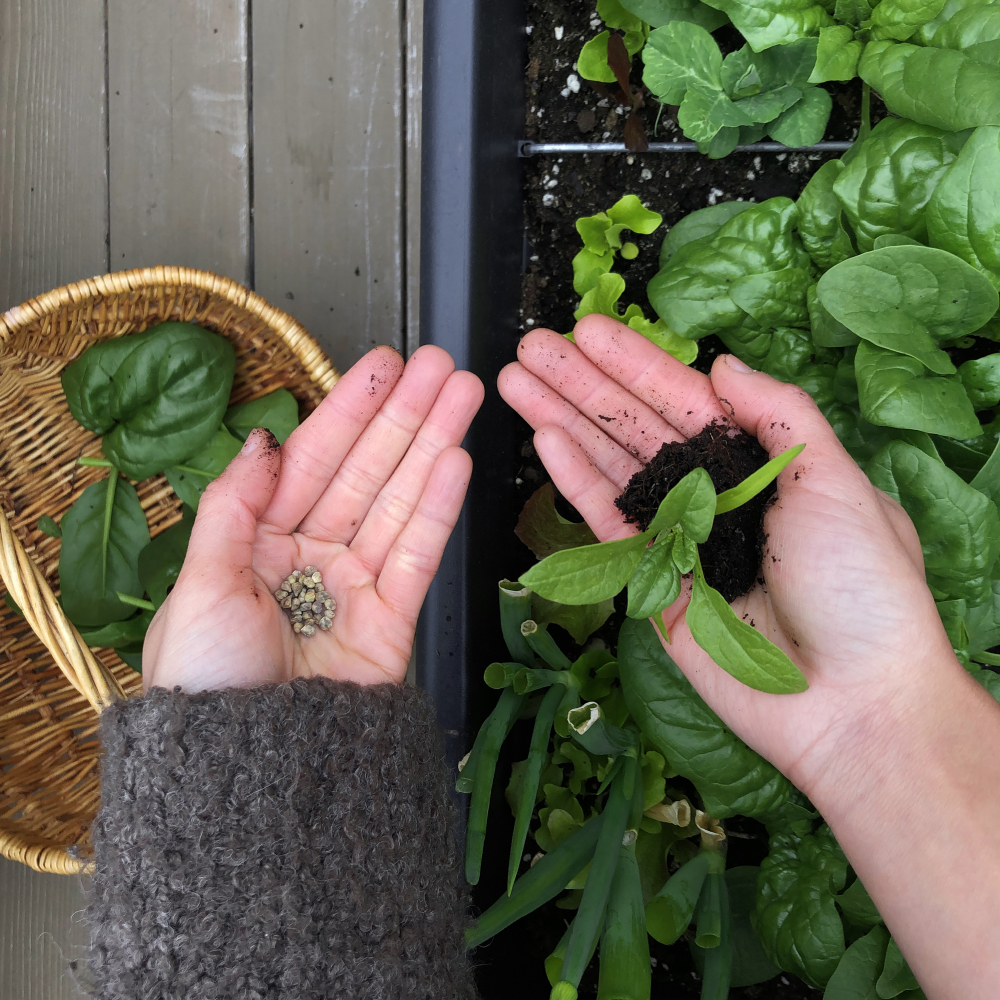The Interrelation of Plant and Soil Health
Guest post written by: Tim Hughes
Organic gardening is as old as humanity itself. Before the industrial revolution, people cared for horticultural and agricultural structures as holistic systems. Gardening involved strengthening and investing in natural systems at work. By doing this, humans have been able to work and grow with the land for thousands of years while maintaining a functional ecosystem.
Since the advent of agrochemicals in the 1940s, however, plant nutrition has been discussed separately from its surrounding ecosystem. As a result of this change, we have seen a loss of understanding of the interconnectedness between plant and soil health and a detriment to soil health and plant production all around the world. I hope to explain a little about soil health and fertility, why plant and soil cannot be thought of separately, and explain what you can do to promote a healthy soil ecosystem in your urban green space.
Illustration from Anthony Huxley’s ‘An Illustrated History of Gardening’, artist unknown
Plant Health
When trying to optimize plant nutrition, people often reach for fertilizers first. If you have ever wondered what the 30-30-30 formulation on the front of the package means, these are the fertilizer ratios of macronutrients, and folk wisdom explains them as “up, down, and all-around” – meaning, the first number refers to benefits above the ground (leaf and stem), the second number benefits below the ground (roots), and the third number all over (both). While this is true, it’s a little more complicated than that.
The three numbers refer to the primary building blocks of plant health: the macronutrients
nitrogen (N)
Nitrogen is responsible for the green growth in plants. It gives the building blocks for chlorophyll production, which is necessary for photosynthesis and gives plants their green colour.
phosphorous (P)
Phosphorous is important for root growth and bloom production—and, by extension, fruit and vegetable production. Plants low in phosphorous can have weak, thin roots that draw up less water and nutrients. Fruits and vegetables low in phosphorous can be smaller in size, have poor nutritional value, or won’t produce crops at all.
potassium (K)
Potassium regulates the plant’s ability to inhale carbon dioxide and exhale oxygen. It also plays a major role in regulating a plant’s water uptake, so healthy amounts of potassium can help improve drought resistance.
All three nutrients are essential to a plant’s ability to create and store energy. And in our modern age of fertilizer science, when levels of one major plant nutrient are low, it is possible to supplement with a fertilizer containing just that one nutrient. For example, if a plant is losing its green colour, a fertilizer with a higher first number (nitrogen) is recommended to boost the green production. Supercharging a plant in macronutrients can give a false sense of health, however. An aspect of plant nutrition that synthetic fertilizers do not often support is that of the micronutrients. Micronutrients are things that plants need to be healthy, but in smaller amounts than that of the three macros. There are over a dozen micronutrients that are essential to plant health, such as copper, zinc, magnesium, molybdenum, and boron. Each micronutrient is responsible for a specific biological function, and if those micronutrients aren’t there, plants will struggle to complete those functions. Throwing synthetic fertilizers onto random plant problems will only compromise the plant’s system further and make problems worse.
Organic fertilizers will go a much longer way toward nourishing the greater plant system because as biological material itself, it already contains many of the micronutrient content that gets stripped in artificial processing. Interestingly, due to the market for targeted synthetic fertilizers, organic fertilizers are increasingly being offered to mimic the familiar, targeted approach to plant macronutrition. But as natural products they have the added and lesser-praised benefit of providing micronutrient support as well. For example, liquid kelp extract is high in the macronutrient nitrogen, but is also high in the micronutrients magnesium and iron.
We’ve already discussed a lot about plant health, and most people stop here. But even with all this discussion of macro vs. micronutrients, there is still an aspect of plant health that is overlooked. This is the microbial health of the soil. Remember we said earlier how important it was to examine and strengthen the whole system? Well, in looking really closely at the macro and micronutrients, we have slipped into an old pattern of seeing the plant as an isolated whole. We have to remember that plants also live in an earthy context. This underappreciated world stands to offer incredible benefits for anyone with an interest in gardens, from the hobbyist to the farmer.
Soil Health
‘Samish’ Spinach grown from seed, nourished by fertile soil
Healthy outdoor soil is the product of many different organisms involved in a complex food web. What we consider as soil is actually less of a thing and more of a process – a dynamic interrelationship between bacteria, fungi, insects, plants, birds, and mammals. When we look at soil, we are looking at different stages within that process. Because of the constant, ongoing interactions between all these different actors, in a very real sense you can’t look at the same soil twice!
Most people are probably familiar with the interrelationships that happen with the larger members of the soil creation system, such as plants and animals. The organic material left behind by birds, insects, plants, and mammals is broken down to eventually feed and fertilize plants. The process of breaking down isn’t just a matter of decaying matter –we have another member of the soil ecosystem to thank for this work. Enter microbes and fungi, which break down external matter that will eventually become the nutrients for the plant. So when it comes to building healthy growing soil, in one sense microbes, fungi and animals are the benefactor, and the plant is the beneficiary.
But this relationship works the other way, too. The plant is not the only beneficiary – it benefits these other players as well. At the most obvious level, plants often provide seeds that feed birds and animals, and/or attract insects that feed these animals. But at a deeper level, plants also contribute to the microbial life of their surrounding soil in a very special way. And to understand this, we have to learn a little more about plant roots.
Many people think that plant roots work like a sponge, simply drawing in water and nutrients from the surrounding soil. Did you know that plant roots actually nourish the soil as well? Try to picture the area where a small root tip comes into contact with the soil around it – this area is called the rhizosphere. It is a special space where plant roots, soil, and soil-dwelling organisms interact. Root tips emit an organic substance called mucilage, a nutrient-absorbing, protective natural lubricant that helps roots push their way down through compressed soil. This mucilage makes the soil nutrients more bioavailable to the plant, but it also feeds and fosters positive microbial population growth. Plant roots also release sugars, enzymes, and other organic compounds for the many soil microbes and organisms (fungi, bacteria, nematodes, etc.) to feed upon. So, the microorganisms do not simply break down organic matter for the plant, but the plant also feeds these surrounding microbes. These are but two of the many complex and synergistic chemical actions that happen in the rhizosphere. It’s important to recognize the complex and delicate interrelationships of all these organisms and the hard work they do to help plants grow, reproduce, and be healthy.
Credit: Barney Livingston
Credit: Quinn Dombrowski
So, in the dark of the soil, there are literally millions of organisms working together. All these organisms play an integral role in maintaining healthy soil. But sometimes these organisms grow weak and depleted. This is especially seen in indoor potted soil, where the environment is more controlled and insects or birds are not available to “contribute”. In these cases, it is still important to feed the microbial life of the soil, and it is possible to do without introducing large animals.
Harvesting
It is possible to support the microbial life of your soil much the same way we promote microbial life in our bodies – through regular application of probiotics. Plant probiotics are a live, fermented solution that contains millions of the same microbes, enzymes, and fungi that naturally exist in undisturbed soil. A tiny amount of this fermented solution is added to the watering can each month or so – this infuses the water with microbial life which will recolonize the soil bit by bit. Replenishing the microbial life of your soil will make soil nutrients more bioavailable to your plants. The plants, in turn, will grow stronger and feed nutrients back into the soil. After a few months of application, your soil will be happily repopulated and strong enough to support its own microbial community.
Plant probiotic has been used around the world since the 1960s to rejuvenate dead soil and help agricultural communities recover from drought. I create my own formulation of plant probiotic, brewing it here in Toronto and adding an extra blend of nutrients that I find to often be lacking in urban green spaces.
Essential Plant Probiotic - indoor blend
A synergistic blend of beneficial soil organisms, enhanced with kelp extract to replenish nutrients specific to indoor soil. Purchase here.
Essential Plant Probiotic - outdoor blend
A synergistic blend of beneficial soil organisms, enhanced with humic acid to replenish nutrients specific to outdoor soil. Purchase here.
With regular use, probiotics restore essential microbes that become depleted when plants are removed from their outdoor environment. The probiotic consists of photosynthesizing bacteria, lactic acid bacteria, yeasts, fermenting fungi, and many other helpful and important micro-organisms. These naturally occurring organisms rebuild biodiversity in your soil, heal and prevent plant damage, and promote nutrient uptake, essentials for a long and happy plant life.
If you are interested in purchasing this product, you can find it through my online store at http://torontohorticulture.ca/. Or, if you are interested in learning more about the health of your indoor or outdoor plants, you can also connect with us for an in-home consultation.
DISCLAIMER: THIS IS NOT A SPONSORED POST. Biggest thanks to Tim for providing such wonderful educational writing.
Show your support by visiting: http://torontohorticulture.ca/
‘Tim Hughes has been working in the field of horticulture and plant care since 1998, and has a diverse educational background that covers the wide spectrum of issues in quality garden care. He holds a diploma in Environmental Landscape Management from Seneca College and a Bachelor of Applied Science in Production Horticulture (food growth) from Olds College, AB. He is certified in pest management, holding Ontario Exterminator’s Licenses, and has continued his education in organic horticulture through Humber College.’
Related Posts:















'Jade Cross' Brussels Sprouts are a hybrid seed boasted to have an early maturation period and resilient nature in particularly cold climates.